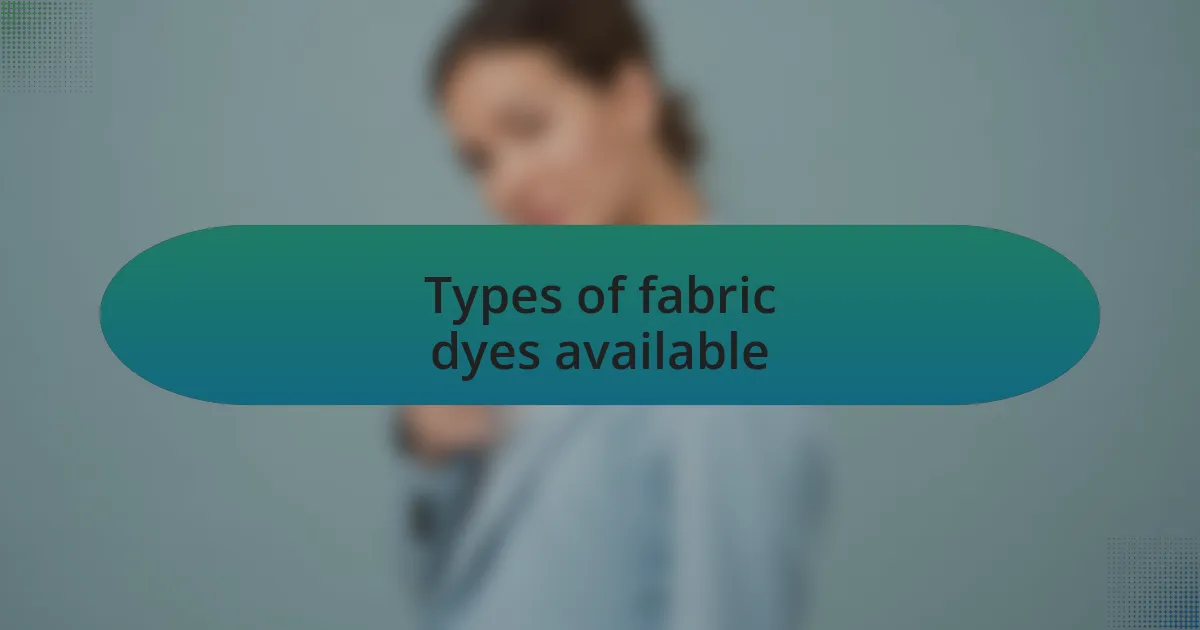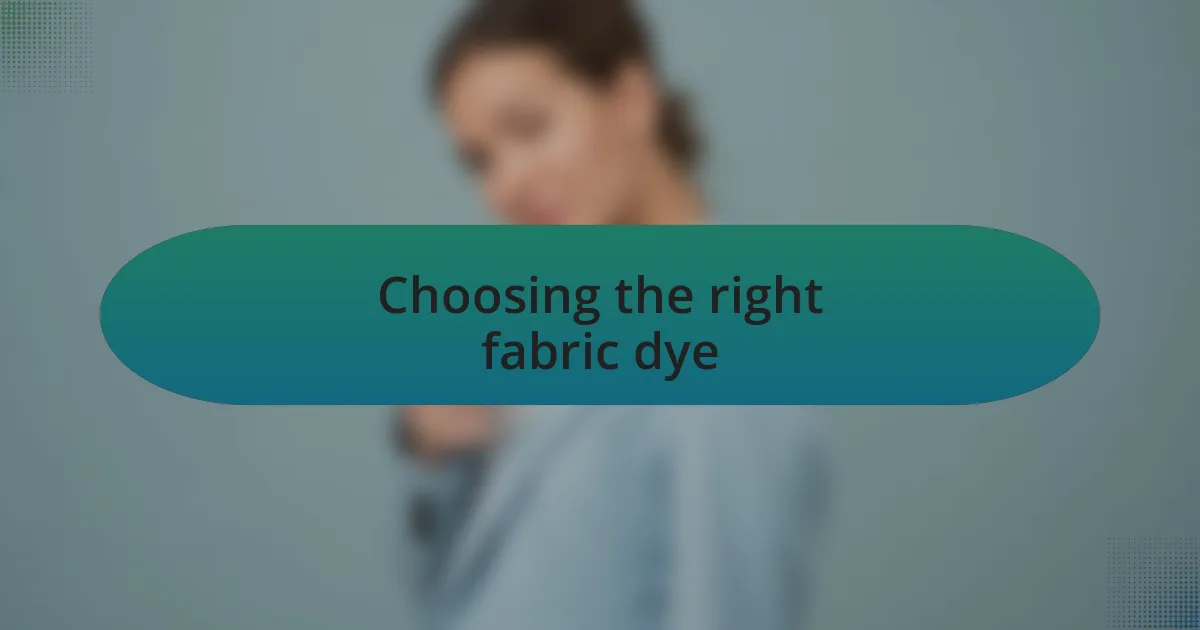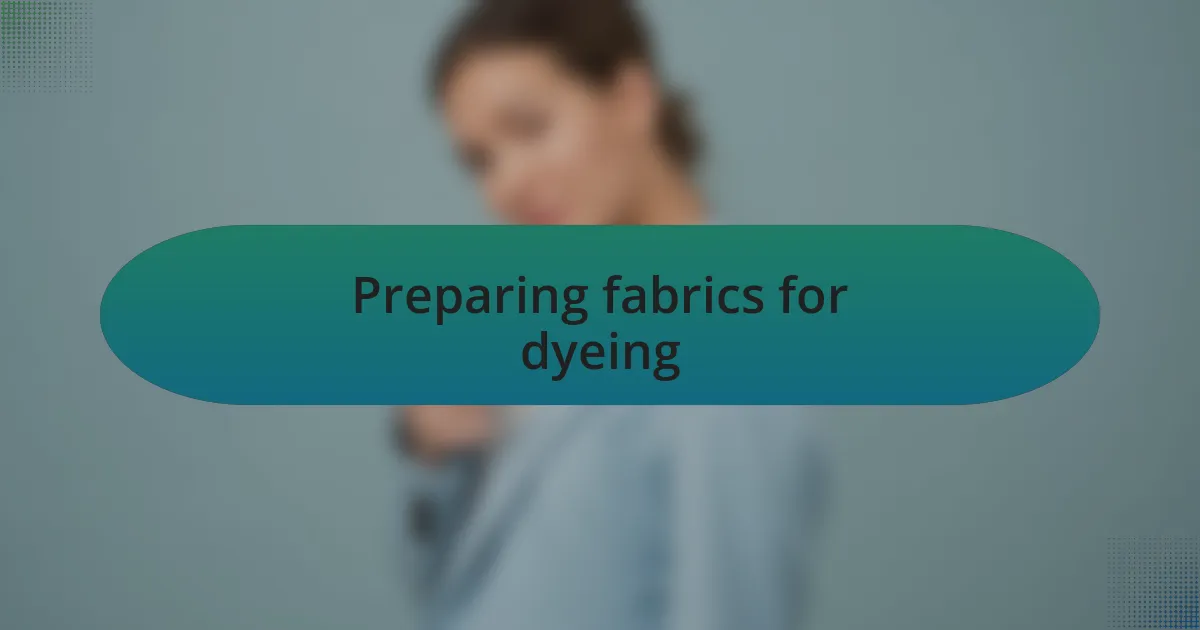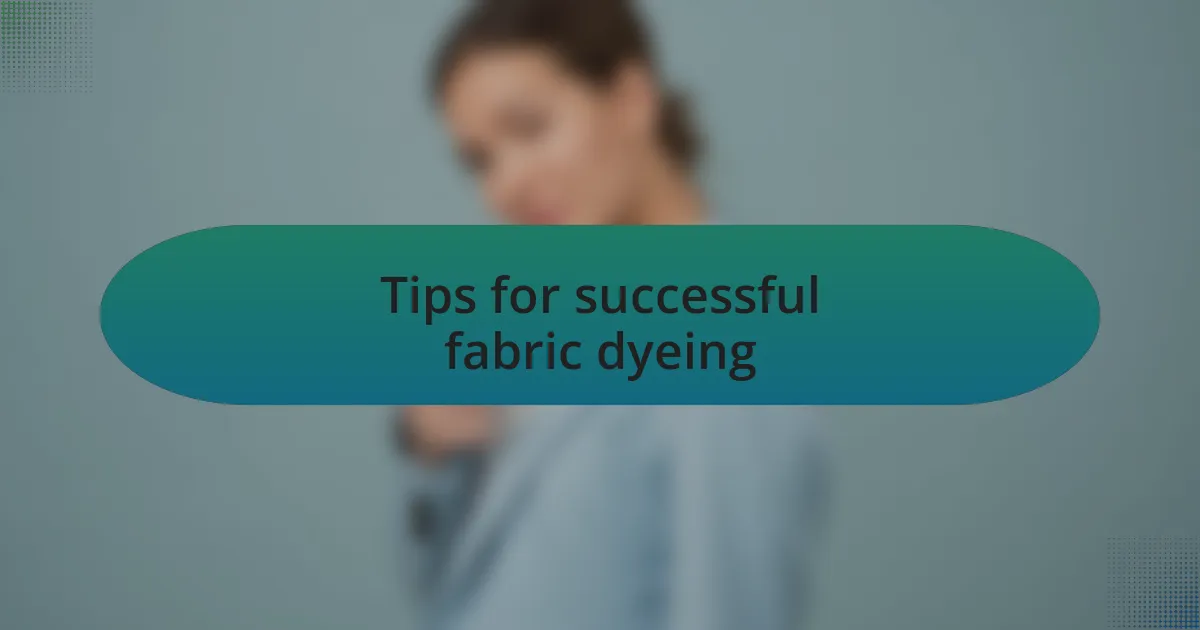Key takeaways:
- Fabric dyes are crucial for both aesthetics and the durability of textiles, emphasizing the importance of investing in quality dyes.
- Understanding different dye types (fiber-reactive, natural, and synthetic) enables designers to make informed choices balancing creativity and environmental impact.
- Proper preparation, including pre-washing fabrics and testing dye on swatches, is essential for achieving vibrant and even colors.
- Experimenting with various dye techniques, such as immersion and tie-dyeing, can enhance creativity and produce unique results.

Understanding fabric dyes importance
Fabric dyes play a pivotal role in the fashion industry, transforming plain textiles into vibrant expressions of creativity. I still remember the first time I mixed colors to dye fabric for a project—it was like unlocking a hidden potential within the material. Can you imagine how a simple piece of cloth can convey emotions just through color?
The significance of fabric dyes goes beyond aesthetics; they influence the durability and overall quality of the garments we wear. Early in my career, I learned the hard way that not all dyes are created equal. I once used a cheaper dye that faded significantly after just a few washes, teaching me that investing in quality dyes is essential for creating long-lasting pieces.
Moreover, understanding fabric dyes allows designers to make more sustainable choices. Reflecting on my experiences, I often ponder—how can we balance creativity and environmental responsibility? By selecting natural or low-impact dyes, we not only enhance our artistic vision but also contribute to eco-friendliness in fashion. This awareness makes each decision feel incredibly empowering.

Types of fabric dyes available
When it comes to fabric dyes, the variety is astounding. For instance, fiber-reactive dyes, which I have used frequently, create a lasting bond with the fabric, resulting in bright, long-lasting colors. I remember dyeing a cotton dress with a set of these dyes—each color came alive in a way that felt almost like magic.
Another category worth mentioning is natural dyes, derived from plants and minerals. While I appreciate the craftsmanship involved in using these dyes, my first attempt was a bit of a learning curve. I used indigo, excited by its rich blue hue, but ended up with a fabric that was more mottled than solid. It made me realize that, while natural dyes can be less predictable, they offer a beautiful, organic quality that modern synthetic dyes sometimes lack.
Lastly, we have synthetic dyes, which are widely used in mass production due to their cost-effectiveness. In my experience, they can achieve vibrant results rapidly, but I often wonder about the environmental implications. One project I worked on with synthetic dyes taught me that while they may be convenient, they come with a responsibility to consider their impact on our planet. Understanding these options helps me make more informed choices as a designer.

Choosing the right fabric dye
Choosing the right fabric dye starts with understanding the material you’ll be working with. I once struggled with a silk scarf project, realizing too late that the dye I selected wasn’t suitable for the delicate fabric. It was a painful lesson in compatibility; now, I always check the dye manufacturer’s recommendations to ensure I’m set up for success.
When you think about color fastness, what comes to mind? For me, it’s the thrill of seeing my creations maintain their vibrancy after several washes. Using a dye with high color retention is crucial, especially when I designed a series of tote bags that went through durability testing. Those bags held up beautifully, and I was proud knowing the colors would endure the test of time.
Cost is always a factor in any project, but it’s essential not to compromise on quality. Early in my dyeing journey, I tried a bargain brand of fabric dye that promised great results. Unfortunately, the colors faded incredibly fast, making me rethink my spending strategy. It’s a balance: I strive to invest in higher-quality dyes, recognizing that they often save me time and frustration in the long run.

Preparing fabrics for dyeing
Preparing fabrics for dyeing is an essential step that often gets overlooked. When I first started dyeing at home, I didn’t realize how vital washing the fabric prior to dyeing would be. I remember dyeing a cotton shirt without pre-washing it, only to find that there were residues from previous treatments that affected the final color. That’s when I learned that a good rinse removes any sizing or dirt, helping the dye adhere better.
Another important aspect is choosing the right temperature for your fabric. I once worked on a project using hot water dyeing techniques for some polyester blends; however, I had a few items wrinkle badly because I didn’t consider the fabric’s heat tolerance. Trust me, nothing beats the satisfaction of pulling out beautifully dyed fabric, free from unwanted surprises because I took the time to adjust the temperature.
Don’t underestimate the benefits of preparing a dye bath, either. When I finally dedicated effort to creating a balanced dye solution with an even mix, the results were stunning. It transformed an ordinary project into something I was truly proud of, as each piece absorbed the dye uniformly, leading to a professional finish.

Techniques for dye application
When it comes to dye application, I’ve found that immersion dyeing is one of the most effective techniques. I remember my first attempt vividly—I submerged a batch of cotton fabrics in a hot dye bath. The magic moment came when I pulled them out, revealing vibrant colors that wrapped around the fibers evenly. It made me realize how deeply the dye penetrates with this method, creating a lasting impact that surface dyeing simply can’t match.
Another technique that has captivated me is tie-dyeing. The first time I twisted, folded, and bound fabric with rubber bands, I felt like an artist in a chaotic gallery. As I dipped sections into different dye baths, I could hardly contain my excitement. Watching the pattern emerge was like unwrapping a beautifully wrapped gift—it was full of surprises! This approach not only engages the imagination but also gives you the freedom to play with colors in a way that’s truly unique.
Spray dyeing has also become a favorite of mine for achieving soft gradients and intricate designs. I recall experimenting with this technique on a scarf, which quickly transformed into a stunning piece of wearable art. The ability to control the flow of dye allowed me to create subtle variations that added depth and texture. Have you ever felt that thrill when a technique not only meets your expectations but exceeds them? That’s the magic of exploring different dye application methods; it keeps my passion for fabric dyeing fresh and ever-evolving.

My personal dyeing experiences
There’s something undeniably thrilling about my early experiences with natural dyes. I vividly recall collecting marigold petals from my garden, eagerly boiling them down to extract their brilliant golden hue. The gentle scent wafting through the air added a layer of nostalgia to the process, making each moment feel deeply connected to nature. Have you ever felt that rush when your efforts yield unexpected beauty? It’s in those moments that I discovered the transformative power of nature in fabric dyeing.
Another memorable dyeing session took place on a rainy afternoon, when I decided to experiment with indigo. I set up a makeshift dyeing station in my living room, and as I dipped my cotton canvas into that deep blue bath, I could hardly believe my eyes. The color transformation was almost magical, fading from green to blue as it emerged from the dye. It taught me that patience is essential; watching the fabric oxidize and deepen in color felt like building anticipation for a long-awaited surprise.
Then there was the time I tried over-dyeing—combining two colors to create a new shade. I took some bright pink fabric and submerged it in a deep purple dye. The result was nothing short of exhilarating; it felt like I had discovered a new color that would never exist again. Have you ever had a creative breakthrough that felt like it unlocked a new realm of possibilities? That experience solidified my belief in experimentation and the endless potential that fabric dyeing holds.

Tips for successful fabric dyeing
When it comes to fabric dyeing, preparation is key, and I learned this the hard way during my early attempts. I remember diving right into dyeing without washing my fabric first, thinking, “What’s the worst that could happen?” To my dismay, the color didn’t adhere properly, leaving me with uneven patches. A simple wash can remove sizing and fabrics’ impurities, setting the stage for vibrant, even color.
Another vital tip is to always test your dye on a swatch before committing to the entire fabric. There’s something uniquely satisfying about witnessing the color develop on a small piece first. I recall a time when I was eager to dye a large piece of silk, but I decided to test the dye on a scrap. It turned out to be far darker than I had anticipated, saving me from a dye disaster that would have left me heartbroken. Isn’t it comforting to have that little safety net?
Lastly, be mindful of your dyeing environment and conditions, as they can significantly impact your results. I once chose a particularly hot day to experiment, thinking the warm sun would enhance the process. Instead, the dye set too quickly, resulting in a splotchy finish that didn’t reflect my vision at all. I learned to embrace the weather and timing, recognizing that sometimes patience leads to the best outcomes. What have your experiences taught you about creating the ideal dyeing conditions?